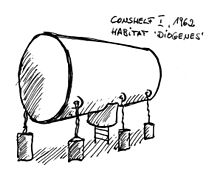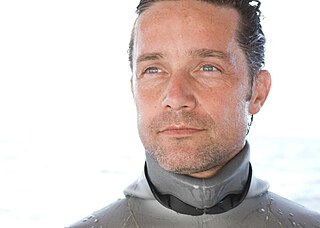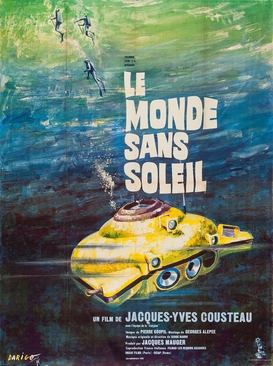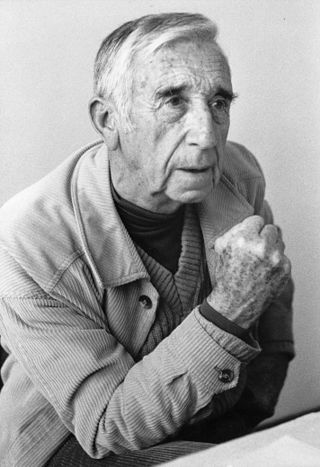Precontinent I

Precontinent I was constructed offshore from Marseille, France, in 1962. Two scuba divers spent two weeks in a small chamber 12 meters deep on the seabed. [3] [1]
Continental Shelf Station Two or Conshelf Two was an attempt at creating an environment in which people could live and work on the sea floor. It was the successor to Continental Shelf Station One (Conshelf One).
The alternate designation Precontinent has also been used to describe the set of projects to build an underwater "village" carried out by Jacques-Yves Cousteau and his team. The projects were named Precontinent I (Conshelf One) [1] , Precontinent II (Conshelf Two) [2] [3] and Precontinent III (Conshelf Three) [4] . Each following project was aimed at increasing the depth at which people continuously lived under water.

Precontinent I was constructed offshore from Marseille, France, in 1962. Two scuba divers spent two weeks in a small chamber 12 meters deep on the seabed. [3] [1]
In 1963, six oceanauts lived 10 metres down in the Red Sea, at Sha’ab Rumi off Sudan, in a starfish-shaped house for 30 days. [2] The undersea living experiment also had two other structures, one a submarine hangar that housed a small, two man submarine referred to as the "diving saucer" for its resemblance to a science fiction flying saucer, and a smaller "deep cabin" where two oceanauts lived at a depth of 30 metres for a week. The undersea colony was supported with air, water, food, power, and all other essentials of life, from a large support team above. Men on the bottom performed a number of experiments intended to determine the practicality of working on the sea floor and were subjected to continual medical examinations.
Two support ships on the surface provided compressed air and other logistical support to Precontinent II. When the experiment ended, two structures were dismantled and removed. The rest became undersea destinations for recreational divers. [3] The work was funded in part by the French petrochemical industry, who, along with Jacques Cousteau, hoped that such manned colonies could serve as base stations for the future exploitation of the sea.
Conshelf Two is documented in Jacques Cousteau's 1964 documentary film World Without Sun , that won Best Documentary at the 37th Academy Awards. [5] [6] [7]
Such colonies did not find a productive future, however, as Cousteau, after forming Conshelf Three a few years later, [4] [8] [9] [10] withdrew his support for such exploitation of the sea and put his efforts toward conservation. It was also found in later years that industrial tasks underwater could be more efficiently performed by undersea robot devices and divers operating from the surface or from smaller lowered structures, made possible by a more advanced understanding of diving physiology and more complex mixtures of breathing gases.[ citation needed ]

Jacques-Yves Cousteau, was a French naval officer, oceanographer, filmmaker and author. He co-invented the first successful Aqua-Lung, open-circuit SCUBA. The apparatus assisted him in producing some of the first underwater documentaries.

RV Calypso is a former British Royal Navy minesweeper converted into a research vessel for the oceanographic researcher Jacques Cousteau, equipped with a mobile laboratory for underwater field research. She was severely damaged in 1996 and was planned to undergo a complete refurbishment in 2009–2011. The ship is named after the Greek mythological figure Calypso.
Simone Cousteau was a French explorer. She was the first woman scuba diver and aquanaut, and wife and business partner of undersea explorer Jacques-Yves Cousteau.

The Aquarius Reef Base is an underwater habitat located 5.4 mi (8.7 km) off Key Largo in the Florida Keys National Marine Sanctuary, Florida, United States. It is deployed on the ocean floor 62 ft (19 m) below the surface and next to a deep coral reef named Conch Reef.

Underwater habitats are underwater structures in which people can live for extended periods and carry out most of the basic human functions of a 24-hour day, such as working, resting, eating, attending to personal hygiene, and sleeping. In this context, 'habitat' is generally used in a narrow sense to mean the interior and immediate exterior of the structure and its fixtures, but not its surrounding marine environment. Most early underwater habitats lacked regenerative systems for air, water, food, electricity, and other resources. However, some underwater habitats allow for these resources to be delivered using pipes, or generated within the habitat, rather than manually delivered.

The SP-350 Denise, famous as the "Diving saucer", is a small submarine designed to hold two people, and is capable of exploring depths of up to 400 metres (1,300 ft). It was invented by Jacques-Yves Cousteau and engineer Jean Mollard at the French Centre for Undersea Research. It was built in the year 1959 and usually operated from Cousteau's ship, the Calypso.

The Great Blue Hole is a giant marine sinkhole off the coast of Belize. It lies near the center of Lighthouse Reef, a small atoll 70 km (43 mi) from the mainland and Belize City. The hole is circular in shape, 318 m (1,043 ft) across and 124 m (407 ft) deep. It has a surface area of 70,650 square metres (760,500 sq ft). It was formed during several episodes of quaternary glaciation when sea levels were much lower. Analysis of stalactites found in the Great Blue Hole shows that formation took place 153,000; 66,000; 60,000; and 15,000 years ago. As the ocean began to rise again, the cave was flooded. The Great Blue Hole is a part of the larger Belize Barrier Reef Reserve System, a UNESCO World Heritage Site.

Frédéric Dumas was a French writer. He was part of a team of three, with Jacques-Yves Cousteau and Philippe Tailliez, who had a passion for diving, and developed the diving regulator with the aid of the engineer Émile Gagnan. Dumas participated with Cousteau in the discovery of deep sea reliefs and flora and fauna of deep sea life and in bringing it to the attention of the general public.

An aquanaut is any person who remains underwater, breathing at the ambient pressure for long enough for the concentration of the inert components of the breathing gas dissolved in the body tissues to reach equilibrium, in a state known as saturation. Usually this is done in an underwater habitat on the seafloor for a period equal to or greater than 24 continuous hours without returning to the surface. The term is often restricted to scientists and academics, though there were a group of military aquanauts during the SEALAB program. Commercial divers in similar circumstances are referred to as saturation divers. An aquanaut is distinct from a submariner, in that a submariner is confined to a moving underwater vehicle such as a submarine that holds the water pressure out. Aquanaut derives from the Latin word aqua ("water") plus the Greek nautes ("sailor"), by analogy to the similar construction "astronaut".

Fabien Cousteau is an aquanaut, ocean conservationist, and documentary filmmaker. As the first grandson of Jacques Cousteau, Fabien spent his early years aboard his grandfather's ships Calypso and Alcyone, and learned how to scuba dive on his fourth birthday. From 2000 to 2002, he was Explorer-at-Large for National Geographic and collaborated on a television special aimed at changing public attitudes about sharks called "Attack of the Mystery Shark". From 2003 to 2006, he produced the documentary "Mind of a Demon" that aired on CBS. With the help of a large crew, he created a 14-foot, 1,200-pound, lifelike shark submarine called "Troy" that enabled him to immerse himself inside the shark world.

Philippe Pierre Cousteau was a French diver, sailor, pilot, photographer, author, director and cinematographer specializing in environmental issues, with a background in oceanography. He was the second son of Jacques Cousteau and Simone Melchior.

The Silent World is a 1956 French documentary film co-directed by Jacques Cousteau and Louis Malle. One of the first films to use underwater cinematography to show the ocean depths in color, its title derives from Cousteau's 1953 book The Silent World: A Story of Undersea Discovery and Adventure.

World Without Sun is a 1964 French documentary film directed by Jacques-Yves Cousteau. The film was Cousteau's second to win an Academy Award for Best Documentary Feature, following The Silent World in 1956.
Philippe Victor Diolé was a French author and undersea explorer.

Philippe Tailliez was a friend and colleague of Jacques Cousteau. He was an underwater pioneer, who had been diving since the 1930s.

Captain George Foote Bond was a United States Navy physician who was known as a leader in the field of undersea and hyperbaric medicine and the "Father of Saturation Diving".

James Raymond Talacek is an American professional aquanaut with the University of North Carolina Wilmington (UNCW). He serves as Oceanographic Field Operations Manager at Aquarius Reef Base, the world's only undersea research laboratory.

Voyage to the Edge of the World is a 1976 French nature documentary film directed by Jacques-Yves Cousteau, his son Philippe Cousteau and Marshall Flaum. The film follows a four-month expedition through Antarctica undertaken between the end of 1972 and the beginning of 1973. It was Cousteau's third and last full-length film, following The Silent World (1956) and World Without Sun (1964). As a difference with those two earlier Cousteau films, both mainly narrated by Jacques-Yves Cousteau himself, on this film Jacques-Yves' voice-over alternates with co-director Philippe Cousteau's voice.
Mission 31 was an undersea expedition organized by Fabien Cousteau. It was originally scheduled for November 2013, but was delayed to June 2014. On June 1, Cousteau and six crew members descended to the undersea laboratory Aquarius in the Florida Keys. Halfway through the expedition, three of crew were replaced, as had been planned. After 31 days, Cousteau and the crew ascended on July 2.

Jacques Rougerie is a French Architect and Oceanographer who specialises in underwater habitats. MAD Architects has revealed its design proposal for the Aquatic Centre for the Paris 2024 Olympics. Envisioning the sports facility as an urban public artwork, showcasing the beauty and hope of Paris, the proposal was created in collaboration with three French architectural studios, Jacques Rougerie Architecture, Atelier Phileas Architecture, and Apma Architecture.